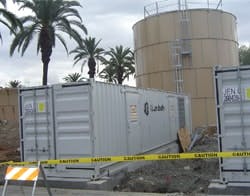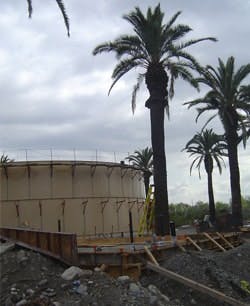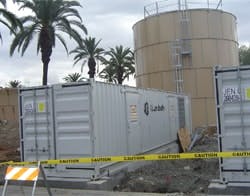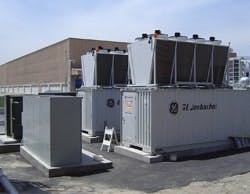Brewing success through sustainability
A unique foundation of brands and 288 years of brewing experience stand behind MillerCoors (www.millercoors.com). Product brands include a variety of domestic, import, craft and specialty beers, such as Coors, Miller, Blue Moon, Peroni, Pilsner Urquell, Henry Weinhard’s, Molson, Hamm’s, Keystone, Mickey’s and many more.
From water usage and packaging sustainability to brewery waste and energy consumption, MillerCoors always looks for ways to reduce its effect on the environment. The company strives to make more beer while using less water, reusing or recycling nearly 100% of the brewery waste. It looks to each of its six major U.S. breweries to seek out the most efficient and environmentally sustainable brewing practices.
A challenge brews at Irwindale
|
View related content on PlantServices.com |
Figure 1. A GE Jenbacher 1,120-KW, IC engine using methane gas fuel generated from the new biogas anaerobic digester powers MillerCoors' 1-MW cogeneration plant.
Opened in 1980, the company’s Irwindale brewery lies 26 miles east of Los Angeles. The brewery employs nearly 600 people who produce 7 million barrels of beer annually.
In the spirit of the MillerCoors commitment to sustainability, executives at the brewery sought a clean, renewable source of plant energy, while simultaneously minimizing emissions and curtailing the cost associated with disposal of brewing waste byproducts by installing an anaerobic digester.
MillerCoors engaged EPS (www.epsway.com), a company specializing in energy management technology for industrial manufacturers, to analyze the situation and propose a solution. EPS performed a plant-wide energy usage analysis to determine the best possible use for the biogas the waste water treatment generates. EPS concluded that because the current natural gas usage facility was remote, it made use of the biogas in the boiler area.
EPS determined the best opportunity for savings and emissions reductions was to build a biogas-fired cogeneration plant using the biogas from the anaerobic digester. The cogeneration plant would generate electricity for the beer-making process and hot water that would be used in heating the anaerobic digester.
With up-front verification from EPS showing the project could provide a compelling return on investment through greater efficiency, as well as less waste and reduced emissions, all coupled with minimal production disruption and in accord with MillerCoors’ sustainability initiatives, the company decided to move forward.
Recipe for a successful solution
Based on the project’s initial analysis and data-driven ROI projections, MillerCoors selected EPS to perform the engineering, design, procurement and construction for a generator and electrical interconnection for a 1-MW biogas-powered cogeneration plant (Figure 1).
Figure 2. The system is housed in two containerized engine enclosures with heat rejection and heat recover mounted externally, with external connections to gas, water and electrical services.
The work started with obtaining air permits from the Southern California Air Quality Management District and preliminary approvals from Southern California Edison for interconnection. EPS started the application process for incentives, working with Southern California Gas for the California Public Utilities Commission Self-Generation Incentive Program. With that in place, EPS began engineering and ordered the major equipment.
After completing engineering and securing a building permit, EPS began constructing the cogeneration system. The system was housed in two containerized engine enclosures with externally mounted heat rejection and heat recovery equipment (Figure 2). The containers were placed on concrete piers and had connections to gas, water and electrical services. Once commissioning had been completed, testing of the electrical interconnection and air emissions began.
Drinking in the savings
Figure 3. This shows the construction of the holding tank and anaerobic digester for the new biogas-powered cogeneration facility.
An anaerobic digester (Figure 3) treats beer waste to produce biogas that fuels the cogeneration plant and produces electricity for the facility. The thermal energy the cogeneration plant produced heated the digester to offset high-quality steam/hot water for use in various beer manufacturing processes. EPS completed the biogas cogeneration project on schedule and within budget.
The biogas-powered cogeneration plant provides 1 MW of power that reduces MillerCoors’ electric utility bill and reduces the brewery’s carbon footprint by providing the necessary power at a lower emissions rate. Excess gas was used for additional power generation capacity. In addition, it helps the brewery reduce waste by using recycled byproducts as fuel.
In addition to reducing the amount of purchased electricity, MillerCoors received a $1 million rebate from the California Public Utilities Commission Self-Generation Incentive Program. One of the largest rebates ever awarded on a project of this kind in the state of California, it cut the simple payback on the project to six months (Table 1).
| Project cost | $1,474,040 |
| Utility rebate | $1,000,000 |
| Net cost | $474,040 |
| Generated power (kWh) | 8,703,936 |
| Annual savings | $936,178 |
| Simple payback (yrs) | 0.502 |
| Internal rate of return (pre-tax) | 99% |
| Net present value (8-yr) | $8,206,645 |
Table 1. The financial impact of the upgrade was positive |
|



